

Eis-zwei-Geissebei is a Carnival festival held in Rapperswil (Switzerland) on Shrove Tuesday.


Eis-zwei-Geissebei is a Carnival festival held in Rapperswil (Switzerland) on Shrove Tuesday.
Its origin may go back to the siege and destruction of the city of Rapperswil at St. Matthew in 1350 by Rudolf Brun, first mayor of the city of Zürich. At that time, compassionate citizens served food to hungry children through the windows of their houses, to which the current practice recalls.
After the traditional "Herrenessen" (dinner of the council members) in the Rathaus Rapperswil and cabaret program with distinguished guests, hundreds of children gather in the main square on Shrove Tuesday. At exactly 15:15 the windows of the town hall open and a fanfare sounds.
A council member asks, “Sind alli mini Buebe doo?” (Swiss German: Are all my boys here?), and the answer is given: “Joo! Eis - Zwei - Geissebei!” (Yes, one, two, goat-leg!), whereupon sausages, bread rolls and Biberli (a sweet) are dropped down to the children on the Hauptplatz (main square). Following the so-called Austeilete, in the evening there is intense activity, and the crowning of the carnival, all Guggenmusik (carnival marching bands) gathered on Lindenhof at Schloss Rapperswil to celebrate a roaring concert.

Carnival or Shrovetide is a Christian festive season that occurs before Lent, consisting of Quinquagesima or Shrove Sunday, Shrove Monday, and Shrove Tuesday or Mardi Gras.

Shrove Tuesday is the final day of Shrovetide, marking the end of pre-Lent. Lent begins the following day with Ash Wednesday. Shrove Tuesday is observed in many Christian countries through participating in confession; the ritual burning of the previous year's Holy Week palms; finalizing one's Lenten sacrifice; as well as eating pancakes and other sweets.
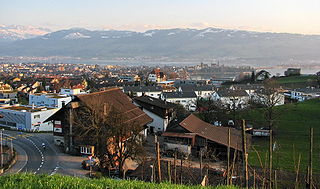
Rapperswil-Jona is a municipality in the Wahlkreis (constituency) of See-Gaster in the canton of St. Gallen in Switzerland. Besides Rapperswil and Jona, which were separate municipalities until 2006, Rapperswil-Jona also includes Bollingen, Busskirch, Curtiberg, Kempraten-Lenggis, Wagen, and Wurmsbach.
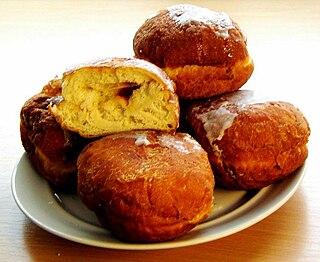
Fat Thursday is a Christian tradition in some countries marking the last Thursday before Lent and is associated with the celebration of Carnival. Because Lent is a time of fasting, the days leading up to Ash Wednesday provide the last opportunity for feasting until Easter. Traditionally it is a day dedicated to eating, when people meet in their homes or cafés with their friends and relatives and eat large quantities of sweets, cakes and other meals usually not eaten during Lent. Among the most popular all-national dishes served on that day are pączki in Poland or Berliners, fist-sized donuts filled with rose hip jam, and angel wings (faworki), puff pastry fingers served with powdered sugar.
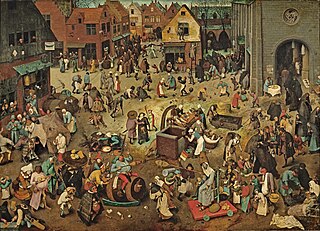
The Fight Between Carnival and Lent was painted by Pieter Bruegel the Elder in 1559. It is a panorama of contemporary life in the Southern Netherlands. While the painting contains nearly 200 characters, it is unified under the theme of the transition from Shrove Tuesday to Lent, the period forty days before Easter.

The Swabian-Alemannic Fastnacht, Fasnacht or Fasnat/Faschnat is the pre-Lenten carnival of Alemannic folklore in Switzerland, southern Germany, Alsace and Vorarlberg.

The Carnival of Basel is the biggest carnival in Switzerland and it is the main Protestant carnival in the world. Basler Fasnacht takes place annually between February and March in Basel. It has been listed as one of the top fifty local festivities in Europe.

Kurentovanje is Slovenia's most popular and ethnologically significant carnival event first organised in 1960 by Drago Hasl and his associates from cultural and educational organizations. This 11-day rite of spring and fertility highlight event is celebrated on Shrove Sunday in Ptuj, the oldest documented city in the region, and draws around 100,000 participants in total each year. In 2016 proclaimed as the 7th largest carnival in the world by Lonely Planet.
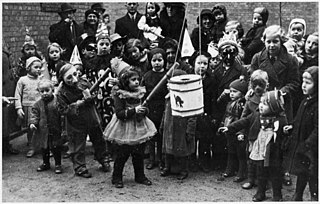
Fastelavn is a Carnival tradition in the Northern European, and historically Lutheran, nations of Denmark, Norway, Sweden, Latvia, Estonia, Iceland, Faroe Islands, as well as Greenland.

The Carnival of Binche is an annual festival held in Binche, Hainaut, Belgium, during the Sunday, Monday, and Tuesday preceding Ash Wednesday.
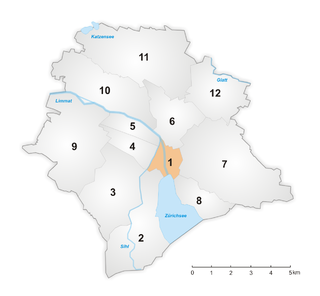
The Altstadt in the Swiss city of Zürich encompasses the area of the entire historical city before 1893, before the incorporation of what are now districts 2 to 12 into the municipality, over the period 1893 to 1934. Die Altstadt approximately corresponds to the area enclosed by the former city ramparts, and is today within the administrative area of the city called Kreis 1.

Rapperswil is a former municipality and since January 2007 part of the municipality of Rapperswil-Jona in the Wahlkreis (constituency) of See-Gaster in the canton of St. Gallen in Switzerland, located between Obersee and the main part of Lake Zurich.

Rapperswil Castle is a castle, built in the early 13th century by the House of Rapperswil, in the formerly independent city of Rapperswil.

Guggenmusik is a term widely used in the Alemannic region of Switzerland, Austria and southern Germany to designate both a Carnival marching band and the type of music it plays.

Rathaus Rapperswil is the former Rathaus of the city government of medieval town of Rapperswil, Canton of St. Gallen in Switzerland. Today, the building houses a café and restaurant, the city archives and a collection of stained glass windows, silverware and paintings. The building and the city archives are listed in the Swiss inventory of cultural property of national and regional significance.

Stadtmuseum Rapperswil-Jona is a museum of local history and art in Rapperswil, canton of St. Gallen in Switzerland.

A variety of customs and traditions are associated with Carnival celebrations in the German-speaking countries of Germany, Switzerland and Austria. They can vary considerably from country to country, but also from one small region to another. This is reflected in the various names given to these festivities occurring before Lent.

Lindenhof in Rapperswil is a moraine hill and a public square being the historic center of Rapperswil, Switzerland.
Carnival is the most important and well-known festivity celebrated in Tarazona de la Mancha, in the Spanish province of Albacete.
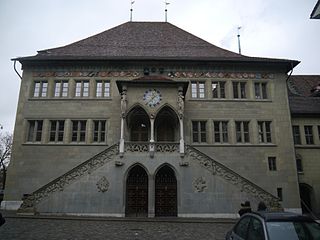
The Bern Town Hall is the building in Bern, Switzerland that houses the Grand Council of Bern, the Executive Council of Bern and the Grand Council of the City of Bern. The building is part of the UNESCO World Heritage Site of the Old City of Berne and is a Swiss heritage site of national significance.